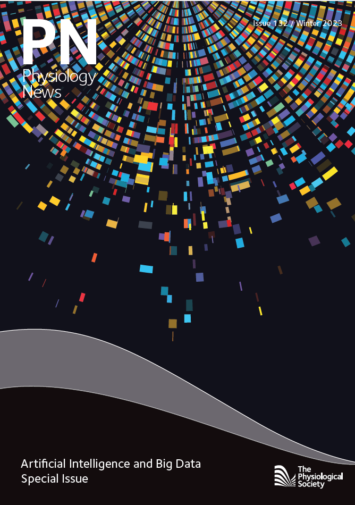
Physiology News Magazine
AI for fairer clinical decisions
How diverse data can improve diagnostics for Parkinson’s Disease
Features
AI for fairer clinical decisions
How diverse data can improve diagnostics for Parkinson’s Disease
Features

Svitlana Surodina
Managing Director at Skein, and Ageing Research at King’s Consortium, King’s College London, UK

Chris Albertyn
Ageing Research at King’s Consortium, and Department of Old Age Psychiatry at King’s College London, UK

Richard Siow
School of Cardiovascular and Metabolic Medicine & Sciences, British Heart Foundation Centre of Research Excellence, Faculty of Life Sciences & Medicine
Director of Ageing Research at King’s Consortium, King’s College London, UK

Ira Haraldsen
Oslo University Hospital, Norway, and Coordinator, AI-Mind
Artificial intelligence (AI) has the potential to transform early diagnosis and subsequent treatment of neurological conditions, such as Parkinson’s disease. Early diagnosis means quicker access to vital care and support that could improve an individual’s quality of life and disease progression. But the applications of AI do not stop there – AI is also helping researchers to better understand the causes of Parkinson’s by assessing the changes in the brain at the initial stages of the disease. These early insights could be the key to developing new and better treatments.
At Skein, we are working on an AI tool to assist clinicians with the decision-making for Parkinson’s. This can be informed by patient data, but unfortunately many datasets are not representative of the population. Improving the quality and diversity of the data will provide the greatest insights for the medical community, allowing for a broader identification of a range of factors, patterns or correlations, which would ultimately improve the accuracy and reliability of diagnosis and prognosis.

AI-based tools for early-stage diagnosis and timely interventions
To enable fairer, more ethical and comprehensive AI, Skein develops a platform that helps evaluate quality, representativeness and value of data for clinical decision-making using distributed collaborative learning approaches. The goals of ensuring validity, security and compliance of patient data collection are becoming especially relevant for innovative organisations who use AI to solve the biggest challenges in preventive healthcare. Among such initiatives is AI-Mind, a European project that aims to reduce the burden of ageing brain conditions by developing novel, AI-based tools to support healthcare professionals in their early-stage diagnosis of people with mild cognitive impairment and offering timely interventions to patients.
Diverse physiological data ensure that clinical decisions are more personalised, thus providing tailored medical advice that is more likely to be effective. More importantly, by ensuring that AI tools are trained on a diverse dataset, it addresses the potential biases that may arise when considering factors like age, gender, race, and socio-economic background. This not only guarantees more equitable healthcare solutions but also ensures that historically marginalised and underserved groups receive medical attention that truly resonates with their unique physiological needs.
Parkinson’s disease, a progressive neurodegenerative disorder
Parkinsons is the fastest growing neurological condition in the world, with approximately 10,000,000 individuals living with it (WHO, 2023; Parkinson’s Foundation). The condition affects the nervous system, especially the nerves involved with movement. This means many will experience motor problems such as shaking, stiffness, and difficulty with balance and coordination (Postuma RB et al., 2016). These symptoms can make it harder to walk and the changes in the brain could also affect speech and difficulties in chewing food and swallowing.
We are still trying to unravel the exact causes and risk factors of Parkinson’s. So far, research has shown us that specific nerve cells in the brain are affected. These are the ones responsible for producing a chemical messenger called dopamine and coordinate our movement, mood and sleep (Latif S et al., 2021). As the condition progresses, these brain cells are lost. As the number of these brain cells deplete in the brain, the levels of dopamine are reduced, which prevents the brain from communicating effectively. This is when symptoms tend to arise.

Why an early diagnosis matters
There is currently no cure for the condition, but regular medication and care can help individuals manage the symptoms and improve their quality of life (Grosset et al., 2007; Islam et al., 2023; WHO, 2023). As symptoms tend to worsen over time, getting an early diagnosis of Parkinson’s disease is pivotal. This enables prompt interventions to manage symptoms more effectively and potentially slow down the disease progression (Parkinson’s Foundation). We also see better responses to medication when treatments are started in the initial stages.
An early diagnosis provides patients with the opportunity to make informed life decisions, they can partake in clinical trials, receive comprehensive care, attend to their non-motor symptoms, as well preparing and building the emotional and psychological support. As well as benefiting the individual, an early diagnosis offers invaluable insights to researchers, aiding them in the advancement of our understanding of Parkinson’s and developing potential treatments.
However, obtaining a diagnosis is not simple.
There is no single definitive test for Parkinson’s disease. Instead, the diagnosis is based largely on clinical evaluation, including the examination of medical history, neuroglial assessment, imaging tests such as Dopamine Transporter Scan (DaTscan) and other multi-step, high-cost procedures.
The transformative potential of AI
AI offers us a way to revolutionise the early detection of Parkinson’s disease. Machine-learning models, a subset of AI, can analyse vast amounts of data, covering everything from medical imaging to subtle variations in speech or motor patterns, which might be imperceptible to humans. By training these models on large datasets of patient records, they can identify patterns and anomalies linked to the earliest stages of the disease.
AI algorithms can analyse medical healthcare records, gait patterns, and even handwriting and voice recordings to discern the slightest tremors or changes indicative of Parkinson’s. AI-enhanced neuroimaging can also detect minute changes in the brain’s structure or functionality long before a clinical diagnosis would typically be possible.

Trusted Healthcare Tools” at the Houses of Parliament in June 2023
Data diversity is a game changer for healthcare
While AI’s analytical prowess is commendable, it is the quality and diversity of the data it analyses that plays a critical role. Although Parkinson’s disease affects people around the world, its presentation, progression, and individuals’ response to treatments might vary depending on regional/ethnic genetic, environmental, and lifestyle factors. That is why it is important for diagnostics and treatment to be personalised. By intentionally including diverse physiological data, especially from underrepresented populations, the medical community can better address and mitigate these disparities.
Medical research has historically been skewed towards certain populations, often Western and Caucasian. When detection and treatment strategies are based predominantly on data from a specific demographic, they might be less effective or even misleading for other groups. Diverse data ensure that the derived conclusions and interventions are universally applicable.
Some patients may not present with “typical” symptoms or might have unusual disease progressions. If the data are limited to a narrow population, these atypical cases might be missed or misdiagnosed. A diverse dataset can better capture the full spectrum of the disease.
Similarly, lifestyle and cultural practices can influence the progression and management of Parkinson’s disease. For instance, diet, exercise habits, and exposure to environmental factors can all play a role in the disease. Diverse data can provide insights into how these factors intersect with the disease, leading to more holistic and individualised care.
Additionally, a diverse dataset allows researchers to ask a broader set of questions and identify patterns or correlations that might be less evident in a more homogeneous group. This can lead to novel insights and breakthroughs in Parkinson’s detection and treatment.
AI is a societal evolution for healthcare
AI in healthcare is not merely a technological evolution; it’s a societal one. That is why it is imperative to engage and discuss AI in healthcare with policymakers. As we integrate these tools more deeply into our healthcare systems, it is paramount to ensure they are safe, effective, and most importantly, equitable.
This is why we joined the preparation and launch of The Physiological Society’s policy report on AI, “From ‘Black Box’ to Trusted Healthcare Tools” at the Houses of Parliament in June of this year. The work highlights the importance of diverse physiological data in creating next-generation AI-based prevention tools. By involving various stakeholders, from clinicians to technologists, the event provided a 360-degree view of the challenges and prospects AI holds for clinical care and the research field.
The discussions held were enlightening, touching upon the ethical, practical, and logistical aspects of AI in healthcare. The emphasis on data diversity privacy, patient autonomy, and the potential of AI to democratise healthcare was particularly salient. By working together with policymakers, we can unlock the potential of AI to revolutionise healthcare and improve patient outcomes for those living with neurological conditions to cardiovascular disease and cancer.
References
Grosset D et al. (2007). A multicentre longitudinal observational study of changes in self reported health status in people with Parkinson’s disease left untreated at diagnosis. Journal of Neurology, Neurosurgery and Psychiatry 78(5), 465-469.
Islam MS et al. (2023). Using AI to measure Parkinson’s disease severity at home. NPJ Digital Medicine 6, 156. https://doi.org/10.1038/s41746-023-00905-9.
Latif S et al. (2021). Dopamine in Parkinson’s disease. Clinica Chimica Acta 522, 114-126.
https://doi.org/10.1016/j.cca.2021.08.009.
Parkinson’s Foundation (no date). Available at: https:// www.parkinson.org/ (Accessed October 2023)
Postuma RB et al. (2016). The new definition and diagnostic criteria of Parkinson’s disease. The Lancet Neurology 15(6), 546-548.
World Health Organization (2023). Parkinson disease. Available at: https://www.who.int/news-room/fact-sheets/detail/parkinson-disease#:~:text=Global%20 estimates%20in%202019%20showed,of%20 over%20100%25%20since%202000 (Accessed October 2023)
